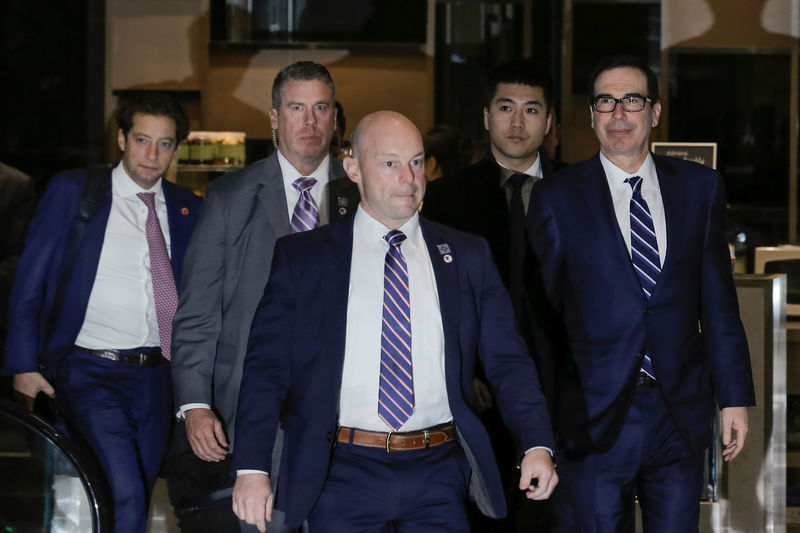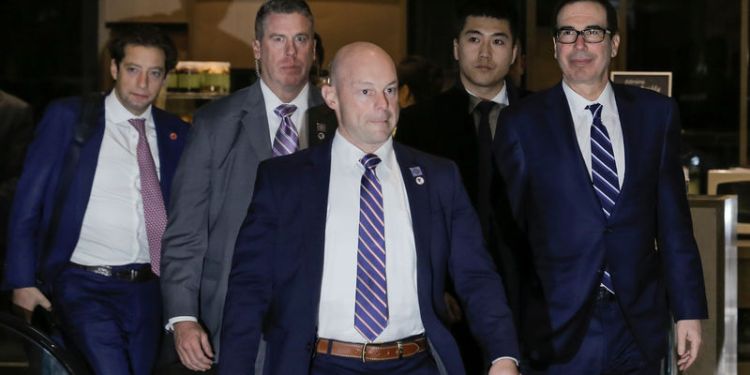 © Reuters. U.S. Treasury Secretary Steven Mnuchin and a member of the U.S. trade delegation to China arrives to a hotel in Beijing
© Reuters. U.S. Treasury Secretary Steven Mnuchin and a member of the U.S. trade delegation to China arrives to a hotel in BeijingBy Ben Blanchard and Philip Wen
BEIJING (Reuters) – U.S. Treasury Secretary Steven Mnuchin said talks with China went well on Wednesday, as the world’s two largest economies try to iron out an agreement to resolve their trade dispute.
“So far, so good,” he said when asked by reporters on how the meetings in Beijing went. He did not say who he met.
Mnuchin said earlier he hoped for “productive” trade meetings as the two countries seek to end a festering dispute that has seen both sides level tariffs at one other.
U.S. tariffs on $200 billion worth of imports from China are scheduled to rise to 25 percent from 10 percent if the two sides cannot reach a deal by a March 1 deadline, increasing pain and costs in sectors from consumer electronics to agriculture.
Mnuchin, asked by reporters as he left his Beijing hotel what his hopes were for the visit, said “productive meetings”. He did not elaborate.
Mnuchin, along with U.S. Trade Representative Robert Lighthizer, arrived in the Chinese capital on Tuesday.
U.S. President Donald Trump said on Tuesday that he could let the deadline for a trade agreement “slide for a little while,” but that he would prefer not to and expects to meet with Chinese President Xi Jinping to close the deal at some point.
Trump’s advisers have previously described March 1 as a “hard deadline,” but Trump told reporters that a delay was now possible.
He said in December that the 90-day truce could be extended, but that he could revert to tariffs if differences could not be resolved.
A growing number of U.S. businesses and lawmakers have expressed hopes for a delay in the tariff increase while the two sides tackle the difficult U.S. demands for major structural policy changes by China aimed at ending the forced transfer of American trade secrets, curbing Beijing’s industrial subsidies and enforcing intellectual property rights.
Trump said last week he did not plan to meet with Xi before the March 1 deadline.
Mnuchin and Lighthizer are scheduled to hold talks on Thursday and Friday with Vice Premier Liu He, the top economic adviser to Xi.
The latest round of talks in Beijing kicked off on Monday with discussions among deputy-level officials to try to work out technical details, including a mechanism for enforcing any trade agreement.
China’s Foreign Ministry referred questions on the talks to the Ministry of Commerce, which did not respond to a request for comment.
A round of talks at the end of January ended with some progress reported, but no deal, and U.S. declarations that much more work was needed.
DODGE A BULLET
James Green, a senior research fellow at Georgetown University, said he believed China was looking to secure a Xi-Trump meeting in the hope that it would make a near-term deal on tariffs far more likely.
“From their point of view, they would have dodged a bullet,” Green, who was USTR’s top official at the U.S. embassy in Beijing until mid-2018, told Reuters by telephone.
But there is growing bipartisan concern in the United States about increasing state control of China’s economy, military activity in the South China Sea, and security issues around its technology companies.
Even if the two sides could come to terms on tariffs, that might not mean an end to trade friction, Green added.
“I think that whatever we might get for an agreement, it will be a pause, because the U.S. government is still going to move forward in the telecoms sector, on law enforcement and legal action, and on sanctions-related issues.”
U.S. Secretary of State Mike Pompeo cautioned allies on Monday against deploying equipment from Chinese telecoms giant Huawei Technologies on their soil, saying it would make it more difficult for Washington to “partner alongside them”.
The United States and its Western allies believe Huawei’s apparatus could be used for espionage, and see its expansion into central Europe as a way to gain a foothold in the European Union market.
Both the Chinese government and Huawei have dismissed these concerns.
Source: Investing.com






















